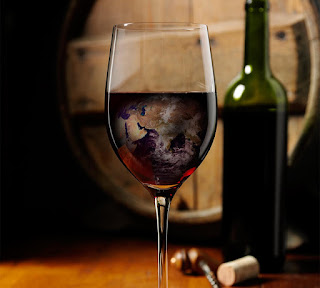My friend Len once explained that he had a “$30 palate”. If you spent anymore on wine for him, you
were wasting money. At an educational
tasting presented by a representative of Castello Banfi, the educator asked
those in attendance to guess what her favorite wine was. We couldn’t guess, so she told us that it was
Riunite Lambrusco. She said, “Give me a
bottle of Riunite and a Wendy’s Spicy Chicken sandwich, and I’m happy!”
In the latest issue of Wine Spectator, a bottle of 2014 Petrus Pomerol is rated at 95
points, and sells for $1,764. It’s a
Merlot. A bottle of 2011 Domaine Chichery sells for $6.99 at your favorite Fine
Wine and Good Spirits store. It’s a Merlot, too. I’m not sure if a wine’s price matches its
quality. Is a $100 bottle of wine really ten times better than a $10 bottle of
wine? How much better can a wine taste?!
It takes a lot of nerve to charge over one thousand dollars for a bottle of
wine. Grapes don’t cost hundreds of dollars... unless you shop at Whole Foods.
But as far as “wine economists” are concerned, the relationship
between the price of a bottle of wine and its quality is low or
nonexistent. In a number of studies, they suggest that wine is not
just poorly priced, but that the different tastes we describe in wine may all
be in our heads.
We all know that certain wines go better with some
types of food. For example, you’re supposed to have red wine with meat and
white wine with fish. (And mouth-numbing acid when you’re eating Irish food.)
In truth, your filet mignon tastes the same whether you
have a vintage French Bordeaux or a Mountain Dew. Connoisseurs, though, are sticklers for the detailed art of wine.
Much like statistics-obsessed baseball fans, or nerds who watch Marvel Universe
movies. Experts find comfort in their belief that, even though we’re all
drinking the same beverage or watching the same movie, they more fully
“experience” what we novices don’t understand. And we’re all experts in
something. (For me, it’s Polka.)
We think of wine as a classier, more
upscale alcoholic beverage. It’s a bad choice of words, then, to refer to
homeless alcoholics as winos. How
come nobody ever describes the drunk hopping the train car as a malt liquoro?
There is nothing about wine that makes it
more prestigious. Biologically, your taste buds don’t know wine to be of a
higher culture. If you spent your life in a cave, and you drank wine and then
beer for the first time, you wouldn’t think one beverage tasted “classier” than
the other.
The truth is that those with power control
the reality of culture. People who drink wine tend to be wealthier and more
educated. Wine tends to be more expensive. Hence, any meal with a little
Chardonnay is classier. If the
nation’s most exclusive country clubs replaced wine with groundhog milk at $75
a bottle, then rodent-milk parties would the newest trend.
Luckily, if you’re on a budget, there are
quality wines are available at affordable prices. Or, if you’re willing to
chance it, you can buy boxed wine. Bota
Box Nighthawk Black is award winning and really good! Hey, if you can eat chicken from a bucket,
you can drink wine from a box. And for people who are really on a budget, I
think Dollar Store is selling wine in a Tostitos bag.
Other than actually drinking the wine, the
two things that wine lovers enjoy doing most are letting their wine breathe and
attending wine tasting events. Wine tasting trips, parties and festivals
continue to rise in popularity. These events give fans a chance to sample
different wines (and to get drunk in a more refined way).
Wine tastings are usually a good time,
especially at our AWS tastings, and attendees tend to be very social. You can
learn about some wines that you might not otherwise try (like box wines). As a
general rule, people are friendlier when alcohol is involved. When you watch
violent riots in the Middle East on television, you can think, “If only these
people had more to drink!”
Since a $5 wine can so easily be mistaken for
a $50 wine, we encourage you to reach for wine on something other than that top
shelf. We've applied this principle and have found some seriously good wine.
But it should also give you pause about everything you eat and drink. If you
boycott expensive wine, should you also avoid sushi and seafood restaurants
because you know that cheap fish can be just as enjoyable? Is a Ruth’s Chris
$53 T-bone six times as good as a Ponderosa $9 T-bone?
No!
Eat what you like, and more importantly, drink what you like! People often tell me, “I don’t know a lot
about wine, but I know what I like”.
That may be true, but the likelihood is that they mean to say “I like
what I know”.
Experiment, taste, and then decide.
Don't forget to check the blog often for news, tips,
and general wine information.











